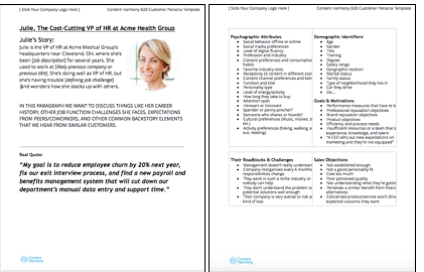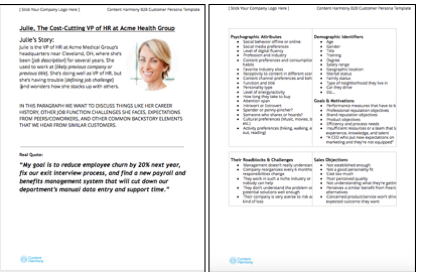So, your content marketing program is off the ground, but despite your promotional efforts, you’re not seeing any audience engagement.
Sometimes it seems to disappear into a black hole.
Other times you watch your content slide past a disinterested audience like dried-up conveyor-belt sushi.
You Probably Haven’t Properly Targeted Your Content
A one-size-fits-all approach to topics, style, format, frequency, timing, and distribution won’t actually fit anyone.
With audiences in complete control of what, why, how, and when they consume online, a content strategy that reflects them is essential. Otherwise, you’re just shooting in the dark.
Persona Profiles & Customer Journey Maps To The Rescue

Our sample B2B Customer Persona. Keep reading to download the Template.
Producing a personal profile and customer journey map for each of your target customer segments is the first step in a properly targeted content marketing strategy.
These two documents will describe your audience as you make strategic decisions that reflect their needs, and will be continually used as a reference. It’s a living document that should be updated, maintained, and taped up on the wall next to your desk if need be.
Both are a bit much for a single blog post, so I’ll just cover the Persona Profile guide this time around.
After the obligatory overview of Personas, I’ll go through it step-by-step and you can download our DOCX template.
You Can’t Assume You Know Your Audience
As marketers, we make a lot of presumptions when it comes to audience insight. After all, surely our marketing and sales team:
- …has actual data about our audience,
- …has segmented our audience appropriately for marketing,
- …and knows how different customer segments impact our business
Unfortunately, this is almost always only partially true.
In my experience, only a third of the customer personas that are produced from a hunch are backed by data when we go to validate them. But, validation (showing your persona is based on data, not hunches) is the hardest part of audience research, and not all companies have the budget for millions of dollars in market research.
So what do we do? Either we ignore it and move forward or we backfill, scrounge, grab the closest “expert” internally or we brainstorm (YACK). We do whatever we have to do to make it happen.
The moment you do that though, you’re already reducing your chances of accurate targeting.
Luckily, in lieu of that million-dollar market research budget, we have a number of ways to “bootstrap” the validation of our audience presumptions.
Be Patient and Insist On Insights
When it comes to customer data, it doesn’t take as long as you think (or cost as much) to produce something that’s better than nothing.
Below are the major buckets of information we want to fill with juicy tidbits when creating a persona’s profile.
A persona profile is the personification (duh) of a specific segment of our overall target audience. One way to do it is to pick a few people (e.g. 3 profiles) from your CRM database that represent “the ideal” customer for each segment, and use those real life customers as your persona template.
With that template in hand, we’ll affinitize their common traits and get rid of outlying personal attributes that may not apply to the segment at large. From there, add key attributes from your audience insights (hold your horses, it’s coming) and research so it represents your broader, core customer segment.
The 8 Sections of A Customer Persona Profile
Our end goal is 2 pages that we can print as a single, double-sided sheet of paper. Our persona profile is going to cover the following 8 components:
- Their Photo
- Their Backstory
- Psychographic Attributes
- Demographic Identifiers
- Their Goals & Motivations
- Their Roadblocks
- Their Sales Objections
- Their Quote
Our Free B2B Customer Persona Template
When we put it all together, our end persona profile looks a bit like this (click here to make a copy of our Google Doc customer persona template):

1 – Their Photo
What does the customer segment look like?
We used to recommend starting out by adding a photo. When done right, an image of someone should come to mind when reading a persona profile. “Oh yeah, I know someone just like that!” is the reaction you’re looking for, so getting a photo really helps in creating a realistic character.
But this can also be problematic if it doesn't properly represent your customer base - by gender, by race, by age, etc.
So, I usually don't include these any more, but we have a general stock photo in our downloadable sample. If you do choose to use one, here's a few tips on finding image sources:
Photo Sources:
- Find a similar stock photo if you’re more comfortable with that
- Another great method we’ve seen suggested is to use a celebrity photo to serve the same purpose, though you need to be careful if that celebrity comes with “baggage” related to their personality (comedians, for example).
Examples:

2 – The Backstory
These are individual facts that make them unique. Bring the damn persona to life. Don’t make them generic mannequins. What’s their story?
Examples:
- Workplace
- Industry experience
- Level of knowledge
- Professional history
- Pastimes and hobbies
Data Sources:
- Existing primary research
- CRM data
- Social profiles of similar people
- Experienced sales team members
- Keywords & terms analysis
3 – Psychographic Attributes
These are characteristics of the persona. It serves to create a “stereotype” (a good thing here).
Examples:
- Social behavior offline or online
- Social media preferences
- Level of digital fluency
- Profession and industry
- Content preferences and consumption habits
- Favorite industry sites
- Receptivity to content in different scenarios
- Content channel preferences and behaviors
- Function and title
- Personality type
- Level of energy/activity
- How long they take to buy
- Attention span
- Introvert or Extrovert
- Spender or penny-pincher?
- Someone who shares or hoards?
- Cultural preferences (Music, movies, books etc.)
- Activity preferences (hiking, walking, eating out, reading)
Data Sources:
- Experienced sales team members
- Content audits
- Competitive audience research
- Existing primary or secondary research (for common segments like Fortune 500 CEOs).
- Email marketing analytics
- Web analytics
- Specialized community and forum conversations
- Nielsen Prizm
- Magazine media kits
- Online ad display planning tools
- Social analytics (example: Followerwonk, Facebook Insights, Social Mention)
4 – Demographic Identifiers
How do we find them?
Uncover the common characteristic data points (generally the easiest to find) to use for identifying an audience in a database. The classic example is you should be able to use these criteria to pull an email list.
Examples:
- Age
- Gender
- Title
- Training
- Degree
- Salary range
- Geographic location
- Marital status
- Family status
- Type of neighborhood they live in
- Car they drive etc…
Data Sources:
- CRM data
- Existing primary or secondary research
- Nielsen Prizm
- Competitive audience research
- Magazine media kits
- Online ad display planning tools
- Social analytics (example: Followerwonk, Facebook Insights, Social Mention)
5 – Their Goals & Motivations
What is the reason behind their behavior?
Describe the goals, needs, or problems they have that make them a fit for your brand or your products and services. What are their options for fulfilling this (Note: this depends, so it’s not part of the examples below)?
Examples:
- Performance measures that have to be hit
- Professional reputation objectives
- Brand reputation objectives
- Product objectives
- Efficiency and process needs
- Insufficient resources or a team that lacks experience, knowledge, and talent
- A CEO who put new expectations on marketing and they’re not equipped
Data Sources:
- Experienced sales team members
- Existing primary research
- FAQs
- Help desk emails
6 – Their Roadblocks
What problems and roadblocks do they run into when they try and achieve their goals?
Examples:
- Management doesn’t really understand
- Company reorganizes every 6 months and responsibilities change
- They work in such a niche industry or role, nobody can help
- They don’t understand the problem or potential solutions well enough
- They’re very averse to risk and any kind of loss
Data Sources:
- Pull in actual quotes from sales emails and customer support tickets
- Experienced sales team members
- FAQs
7 – Their Sales Objections
What are their major “deal killers” when buying from you?
Why do they usually reject or turn away from companies in your industry when making a purchase decision?
Examples:
- Not established enough
- Not a good personality fit
- Cost too much
- Poor perceived quality
Data Sources:
- Pull in actual quotes from sales emails and customer support tickets
- Experienced sales team members
- FAQs
8 – Their Quote
Give them a quote that defines their point of view.
What kind of statement would they make that you hear over and over from people like this?
Example:
“My goal is to reduce employee churn by 20% next year, fix our exit interview process, and find a new payroll and benefits management system that will cut down our department’s manual data entry and support time.”
Data Sources:
- Pull in actual quotes from sales emails and customer support tickets
- Experienced sales team members
- CRM data
- Existing primary research
Next Up: Mapping Out The Customer Journey For This Customer Segment
After the persona profile, we map the customer persona to their unique buying journey, so we don’t want to repeat information that is on the persona profile. The persona profile contains customer insights that hold true at all times, while the journey map breaks down their experience by stage so we can target them based on where they are in the funnel.
✉️ Get an email when we publish new content:
Don't worry, we won't bug you with junk. Just great content marketing resources.
Ready To Try
Content Harmony?
Get your first 10 briefs for just $10
No trial limits or auto renewals. Just upgrade when you're ready.

You Might Also Like:
- Content Brief Templates: 20 Free Downloads & Examples
- The Keyword Difficulty Myth
- How To Find Bottom of Funnel (BoFU) Keywords That Convert
- Bottom of Funnel Content: What Is BOFU Content & 10 Great Examples
- 20 Content Refresh Case Studies & Examples: How Updating Content Can Lead to a Tidal Wave of Traffic 🌊
- How to Create Editorial Guidelines [With 9+ Examples]
- Content Marketing Roles
- How To Write SEO-Focused Content Briefs
- The Content Optimization Framework: [Intent > Topic > UX]
- How To Update & Refresh Old Website Content (And Why)
- 12 Content Marketing KPIs Worth Tracking (And 3 That Aren't)
- 16 Best Content Writing Tools in 2024 (Free & Paid)
- How to Create a Content Marketing Strategy [+ Free Template]
- How To Create Content Marketing Proposals That Land The Best Clients
- What Is A Content Brief (And Why Is It Important)?
- How To Create A Dynamite Editorial Calendar [+ Free Spreadsheet Template]
- How to Use Content Marketing to Improve Customer Retention
- Types of Content Hubs: 5 Approaches & 30+ Examples
- How To Do A Content Marketing Quick Wins Analysis
- There's A Better Way To Measure Keyword Difficulty